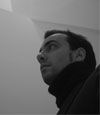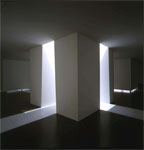|
Pablo Lorenzo–Eiroa arch studio is based in Buenos Aires and as a design practice in New York City, and he has been integrating theoretical speculation and professional practice in different associations since 1998, with work ranging from academic research through scholarships and publications, to professional architecture design in private and state commissions. He currently teaches architecture design and advanced visual studies at the Cooper Union, New York. He has participated as a visiting critic and competition juror at New York City Alliance for Young Artists, Cornell University, the University of Pennsylvania, the Architectural Association, University of Applied Arts Vienna, Columbia University, and the University of Buenos Aires.
He collaborated with Peter Eisenman as a project architect and as a senior designer in a number of competitions and projects since 2002, including: three installations in Europe during 2004–2005 (Carlo Scarpa’s Castelvecchio in Verona, the IX Architecture Venice Biennale, and in the MAK Museum in Vienna); the Arizona Cardinals Stadium (2003); Second Prize for the Napoli TAV terminal competition in Italy (2003); designs for the WTC site published by the New York Times (2002) and the New York Magazine (2002); and he participated as a project architect for the team Richard Meier – Peter Eisenman – Charles Gwathmey – Steven Holl, one of the finalist submissions for the Innovative Design Ideas for the World Trade Center Site organized by the Lower Manhattan Development Corporation, New York City (2002).
Mr. Lorenzo–Eiroa received his architecture degrees from the University of Buenos Aires School of Architecture, Design and Urbanism (1997) where he is developing his second Master’s thesis under a scholarship (1999–2001) and from Princeton University (M.Arch II); he completed a post-graduate seminar at the Superior School of Fine Arts Ernesto de la Carcova (1998); and won the Fulbright Scholarship and National Endowment for the Arts Scholarship (2001–2004) to continue his research at Princeton University School of Architecture with full scholarship (2001–2004). His Master of Architecture Thesis proposed an architectural machine that worked space, time and ecology, transforming environmental forces to generate artificial landscapes as feedback, developing a unique system of floating architecture foundations that become fixed by sedimentation. At Princeton he completed research from four Ph.D. seminars and won scholarships and prizes including the EC–US international workshop in Barcelona (ETSAB) and Los Angeles (UCLA) (2001, 2002), and the Butler Thesis Research Prize, to analyze architecture and infrastructural effects on offshore and shore structures, for the Shearwater North Sea Central in the UK and the Holland Polders (2003). He taught at the University of Buenos Aires School of Architecture (1997–2001), architecture design with the Cathedra Solsona–Salama with S. Foster, and visual studies with the Cathedra Garcia Berdinas with Roberto Lombardi. He also developed research for the SICyT, and has published and edited articles, such as his collaboration for the architecture book Solsona Entrevistas. Apuntes para una Autobiografia, by Ediciones Infinito (1998).
Pablo Lorenzo–Eiroa arch studio’s projects have been published in different media; among others, his mixed-use cultural and residential building proposal for the World Trade Center Site was part of Think Big: The Master’s Plan, a research group organized by the New York Times Magazine in 2002 and curated by Herbert Muschamp, which included discussions and projects from Eisenman, Koolhaas, Hadid, Meier, Holl, and other architects and planners. He has been involved in the design and building of projects in South America, the U.S., and Europe. In Buenos Aires he has designed, developed, exhibited and published many projects, among others, a Second Prize for the Development of Ideas for Ciudad Universitaria, and a Selection for Promenades in Recoleta (1998–2000), a Housing competition for Barcelona’s El Raval (UIA selection), a Public Shore Park in Vicente Lopez–North Buenos Aires (2000), some residential buildings and houses (1998–2007), associated and collaborating alternatively with Meredith Bostwick, Justo Solsona, Ciro Najle, Francisco Cadau, Santiago Pages, and others.
For further information you may visit www.pabloeiroa.com or contact: eiroa@alumni.princeton.edu

|









